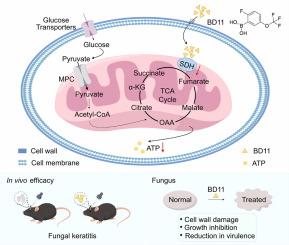硼酸衍生物通过损害能量代谢抑制白色念珠菌的生长
IF 13
1区 综合性期刊
Q1 MULTIDISCIPLINARY SCIENCES
引用次数: 0
摘要
真菌感染是一个全球性的健康问题,对人类福祉有重大影响。其中,难治性、威胁视力的真菌性角膜炎对眼部健康构成严重威胁。这强调了迫切需要开发新的抗真菌药物,以满足临床需求。目的筛选具有较强抗真菌活性的含硼化合物。然后对所选化合物进行体外和体内生物活性评价,并对其抗真菌机制进行研究。方法采用最小抑菌浓度法、耐药性法、时间杀伤曲线法、菌丝和生物膜抑制法对含硼化合物的抑菌效果进行评价。评估候选化合物的体内和体外药物相似性。采用转录组测序、SYTOX Green染色、DiSC3(5)染色、麦角甾醇结合实验、山梨醇拯救实验、透射电镜、细胞内活性氧和三磷酸腺苷(ATP)含量测定、琥珀酸脱氢酶(SDH)活性测定、钙荧光白染色和RT-qPCR等方法研究候选化合物的抗真菌机制。结果化合物BD11具有较强的抗真菌活性和较低的细胞毒性。BD11损害线粒体功能,降低SDH活性,降低细胞内ATP水平,破坏细胞壁完整性,从而有效抑制白色念珠菌的生长和毒力。重要的是,在小鼠FK模型中,BD11显著减轻了角膜损伤。结论复方BD11在抗真菌感染方面具有良好的临床应用潜力。该研究为发现和开发治疗真菌疾病的新型抗真菌药物提供了新的见解。本文章由计算机程序翻译,如有差异,请以英文原文为准。

Boronic acid derivatives inhibit Candida albicans growth by compromising energy metabolism
Introduction
Fungal infections represent a global health concern with significant implications for human well-being. Among them, refractory and sight-threatening fungal keratitis (FK) poses a serious threat to ocular health. This underscores an urgent need for developing novel antifungal agents to meet clinical demands.Objective
This study aimed to screen boron-containing compounds for potent antifungal activity. The selected compounds were then subjected to in vitro and in vivo bioactivity evaluation, and their antifungal mechanisms were investigated.Methods
The antifungal effects of boron-containing compounds were evaluated using minimum inhibitory concentration assays, resistance studies, time-kill curves, and hyphal and biofilm inhibition assays. The in vitro and in vivo drug-likeness of the candidate compounds was assessed. Transcriptome sequencing, SYTOX Green staining, DiSC3(5) staining, ergosterol binding assays, sorbitol rescue assays, transmission electron microscopy, intracellular reactive oxygen species and adenosine triphosphate (ATP) content assays, succinate dehydrogenase (SDH) activity assays, calcofluor white staining, and RT-qPCR were employed to investigate the antifungal mechanisms of the candidate compounds.Results
In this study, we identified compound BD11 as a promising candidate with potent antifungal activity against various pathogenic fungi and low cytotoxicity. BD11 impaired mitochondrial function, reduced the activity of SDH, decreased intracellular ATP levels, and disrupted the integrity of the cell wall, thereby effectively inhibiting the growth and virulence of Candida albicans. Importantly, in a murine FK model, BD11 significantly attenuated corneal damage.Conclusion
These results highlight the excellent clinical potential of compound BD11 in combating fungal infections. This study provides new insights for the discovery and development of novel antifungal agents for the treatment of fungal diseases.求助全文
通过发布文献求助,成功后即可免费获取论文全文。
去求助
来源期刊

Journal of Advanced Research
Multidisciplinary-Multidisciplinary
CiteScore
21.60
自引率
0.90%
发文量
280
审稿时长
12 weeks
期刊介绍:
Journal of Advanced Research (J. Adv. Res.) is an applied/natural sciences, peer-reviewed journal that focuses on interdisciplinary research. The journal aims to contribute to applied research and knowledge worldwide through the publication of original and high-quality research articles in the fields of Medicine, Pharmaceutical Sciences, Dentistry, Physical Therapy, Veterinary Medicine, and Basic and Biological Sciences.
The following abstracting and indexing services cover the Journal of Advanced Research: PubMed/Medline, Essential Science Indicators, Web of Science, Scopus, PubMed Central, PubMed, Science Citation Index Expanded, Directory of Open Access Journals (DOAJ), and INSPEC.
 求助内容:
求助内容: 应助结果提醒方式:
应助结果提醒方式:


